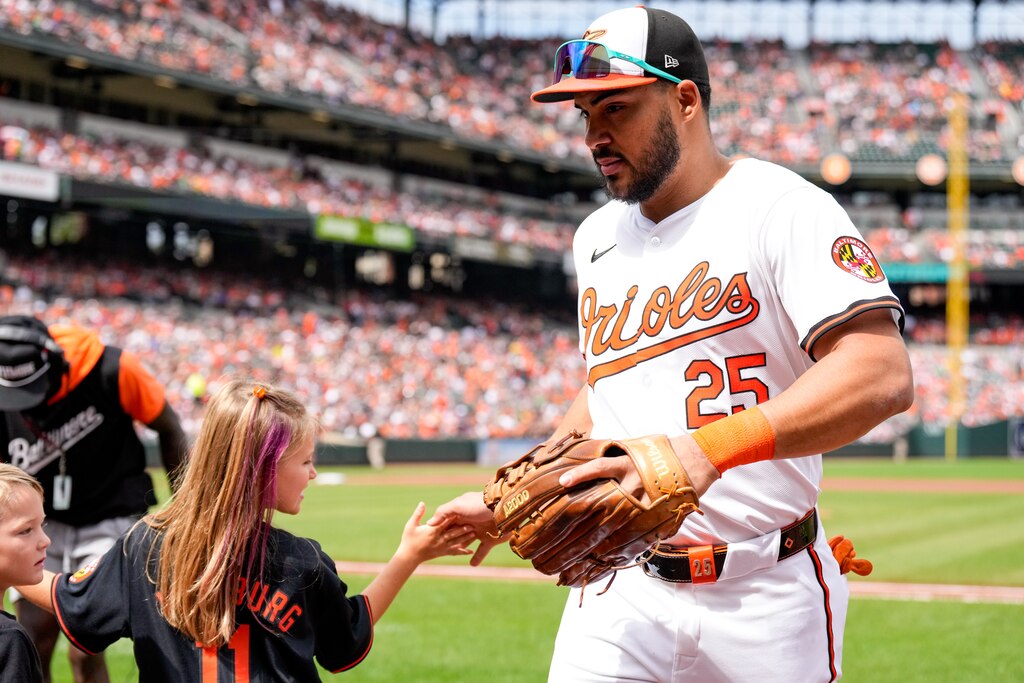To call a baseball personnel decision a tough one is an easy thing to do, even when there’s a simple and straightforward choice that’s the right one, only slightly uncomfortable.
Then there are the ones with valid points on both sides and strong cases to be made. It’s even worse when they’re in direct opposition to one another. And that’s kind of where I feel the Orioles’ decision on Anthony Santander is going.
Without giving too much validity to the made-up (let’s call them what they are) contract projections for Santander this winter, it seems the Orioles’ move is to make him the qualifying offer, welcome him back for $21.05 million for 2025 if he accepts it and take a draft pick if he doesn’t and signs elsewhere.
Beyond that, though, his future in Baltimore feels tied to whatever the Orioles’ front office thinks should happen with the offense. And as much as Santander has meant to this team the last few seasons — all of which deserves to be recognized — it’s hard to reconcile the Orioles’ desire to rely less on home runs (to say nothing of the wishes of those who were frustrated watching them in the second half) and the potential for a long-term Santander contract. His offensive value is heavily reliant on home runs, and he is a streaky slugger at that.
The Baltimore Banner thanks its sponsors. Become one.
Santander’s 44 home runs were a career high and helped him to the best full season of his career (excluding his injury-shortened, pandemic-shortened 2020 season). Santander had an .814 OPS and 129 wRC+, both of which are objectively good. Yet, in the last decade, only three players (Todd Frazier in 2016, Albert Pujols in 2015 and Joey Gallo in 2018) had a lower OPS in the 53 instances of a player having at least 40 home runs in a season. By wRC+, it’s a little better, with 15 players lower than Santander, but in weighted on-base average, Santander’s season is again fourth worst in the sample.
The reason for that comes down to a few factors; one is Santander’s limited on-base capabilities. His walk rate of 8.7% was a career high as well, the third straight season in which it was over 8%, and he was respectably in the 60th percentile for walk rate this year. Put together with a swing that produces a lot of power but also in 2024 had the highest fly ball rate among qualifiers in the game, you’re left with a boom-or-bust offensive output. The batted balls he produces either leave the park or are fly balls, which have a low expected batting average.
Read More
Put those things together and the resulting output is that Santander is mostly reliant on his power to provide offensive value. I never personally found any flaw with the way the Orioles have instructed and taught their players at the plate, in terms of pursuing hard contact at good angles and using swing decisions to achieve those more consistently. However, the season played out in a way that validated criticism that the offense didn’t function well unless it was hitting home runs.
Santander’s home runs, particularly at the start of the second half when the club’s offensive fortunes started to turn, were incredibly valuable to the Orioles this year. Santander was an All-Star for a reason. That kind of presence in the middle of the lineup is imposing, especially when the rest of the cogs around him are functioning at a high level.
The issue is that, in the second half, they weren’t — and that was even as Santander hit 20 of his 44 home runs with an .828 OPS. Although the Orioles will have new hitting coaches next year, nothing about any of the conversations I’ve had this month suggests a major overhaul in philosophy. The lineup around Santander probably isn’t going to change much either.
The Baltimore Banner thanks its sponsors. Become one.
That means the Orioles can go one of two ways. They can bet on a few reasonable outcomes unrelated to Santander — a return to form for Adley Rutschman, a year of experience allowing Jackson Holliday to be the table setter he’s meant to be, another step up from Colton Cowser and Jordan Westburg — and then you have a lineup that can afford the homer-reliant output they’ve come to expect from Santander.

Or they can take whatever it would cost to bring him back and redeploy those resources on a player with a bit more of a favorable profile for the middle of their order who can provide more consistent value when the ball isn’t leaving the park.
I can’t imagine a data-informed front office like the Orioles’ will have a favorable view of paying for a slugger who just turned 30, though, with the promise of new resources available from David Rubenstein and company, it’s possible they’ll be more risk tolerant than in the past.
This one feels deeper than just the binary evaluation of whether it will be a good deal or not. The extent the Orioles are serious about changing their offense will only be known by the measures they take to change it. The staffing decisions they make will be one part of that. So, too, will be whether Santander fits into their vision for the optimal Orioles lineup.




Comments
Welcome to The Banner's subscriber-only commenting community. Please review our community guidelines.